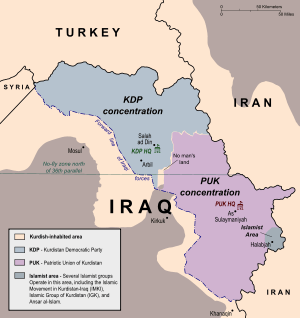Kurdistan Islamist Conflict
| Kurdish Islamist Conflict | |||||||
|---|---|---|---|---|---|---|---|
| Part of The Iraqi no-fly zones conflict and the Iraq War | |||||||
 Iraqi Kurdistan 2003 | |||||||
| |||||||
| Belligerents | |||||||
|
|
| ||||||
| Commanders and leaders | |||||||
|
|
| ||||||
| Strength | |||||||
|
Ansar al-Islam: 700-1000 fighters[4] IUM: 40 fighters[3] |
KDP and PUK: 70,000[5] ~40 Americans[6] | ||||||
| Casualties and losses | |||||||
| 200+ killed[7] | Unknown, at least 45 killed and 93 wounded | ||||||
The Kurdistan Islamist Conflict was a military conflict in Iraqi Kurdistan between the Islamist militant group Ansar al-Islam and the two main Kurdish parties; the Kurdish Democratic Party and the Patriotic Union of Kurdistan. The conflict began in 2001, but subsequently merged with the larger 2003 invasion of Iraq, which led to the defeat of Ansar al-Islam. After the invasion, Ansar al-Islam continued a low level terrorist insurgency against the Kurdish Democratic Party and the Patriotic Union of Kurdistan.
Background
Ansar al-Islam was formed in September 2001 when Jund al-Islam merged with a splinter group from the Islamic Movement of Kurdistan, under the leaderhsip of Mullah Krekar.[8] According to the Patriotic Union of Kurdistan, the group consisted of Arabs and Iraqi Kurds who had gone to Afghanistan to fight alongside Taliban against the Soviet invasion in the 80s. They came back to Kurdistan after the defeat of the Taliban government in Afghanistan in 2001.[8] Ansar al-Islam imposed Sharia in the villages they controlled around Biyara, close to the border to Iran.
Ansar al-Islam's rule
Human Rights Watch has accused Ansar al-Islam of committing atrocities against the civilian population in the territory which they controlled. It has been alleged that Ansar al-Islam harshly persecuted the Kaka'i religious minority, and enforced strict Islamic law. Human Rights Watch also accused Ansar al-Islam fighters of torturing prisoners and summarily executing captured PUK soldiers.[3]
Assassination attempts
An unsuccessful attempt was made on the life of Barham Salih in April 2002 by Ansar al-Islam. At the time, Saleh was the PUK Regional Government Prime Minister.[9] Later in February 2003 Ansar al-Islam assassinated the prominent PUK commander Shawkat Haji Mushir, along with five other people.[10]
In March 2004 the US State Department officially classified Ansar al-Islam as a terrorist organization.[11]
2003 Invasion of Iraq
During the 2003 Invasion of Iraq, US forces aided the PUK in attacking Ansar al-Islam. In late March 2003, PUK forces supported by American special forces captured Halabja after several days of heavy fighting. The surviving Ansar al-Islam forces fled to Iran.
American intelligence personnel inspected the suspected chemical weapons site in Sargat and discovered traces of Ricin in the ruins, as well as potassium chloride. They also discovered chemical weapons suits, atropine nerve gas antidotes, and manuals on manufacturing chemical weapons, lending credence to the idea that the site was related to the manufacture of chemical weapons and poisons.[12]
After the invasion
After their defeat in Iraqi Kurdistan, Ansar al-Islam joined the Iraqi insurgency in Iraq. Several terrorist attacks in the Irbil area have been linked to Ansar al-Islam, including the suicide bombing of the PUK and KDP headquarters in Irbil that killed 117 people. They also carried out the bombing of the Mount Lebanon Hotel in Baghdad on March 17, 2004.[11]
Notes
- 1 2 http://middleeastreference.org.uk/iraqiopposition.html#igk
- ↑ Masters of Chaos, Chapter 13 p. 7
- 1 2 3 "Ansar al-Islam in Iraqi Kurdistan (Human Rights Watch Backgrounder, )". Retrieved 20 March 2015. line feed character in
|title=at position 34 (help) - ↑ "Ansar al-Islam". Retrieved 20 March 2015.
- ↑ http://cgsc.cdmhost.com/cgi-bin/showfile.exe?CISOROOT=/p4013coll3&CISOPTR=363
- ↑ Surrogate Warfare: The Role of U.S. Army Special Forces - MAJ Isaac J. Peltier, US Army - p. 35
- ↑ John Pike. "Iraqi Insurgency". Retrieved 20 March 2015.
- 1 2 "Ansar al-Islam in Iraqi Kurdistan (Human Rights Watch Backgrounder, )". Retrieved 20 March 2015. line feed character in
|title=at position 34 (help) - ↑ "Terrorist Organization Profile - START - National Consortium for the Study of Terrorism and Responses to Terrorism". Retrieved 20 March 2015.
- ↑ "BBC NEWS - Middle East - Gunmen kill Iraqi Kurdish leader". Retrieved 20 March 2015.
- 1 2 John Pike. "Ansar al Islam (Supporters of Islam)". Retrieved 20 March 2015.
- ↑ Masters of Chaos, Chapter 13 p. 25-26